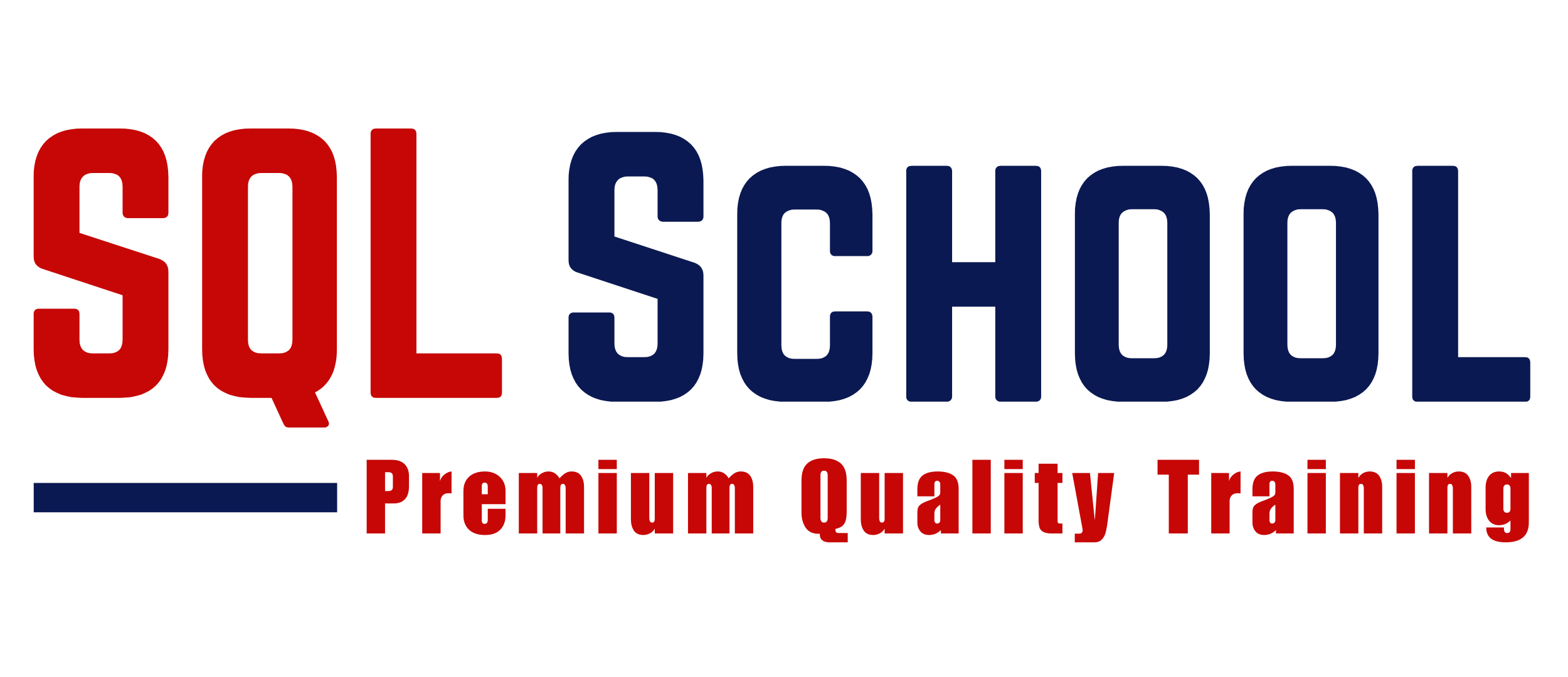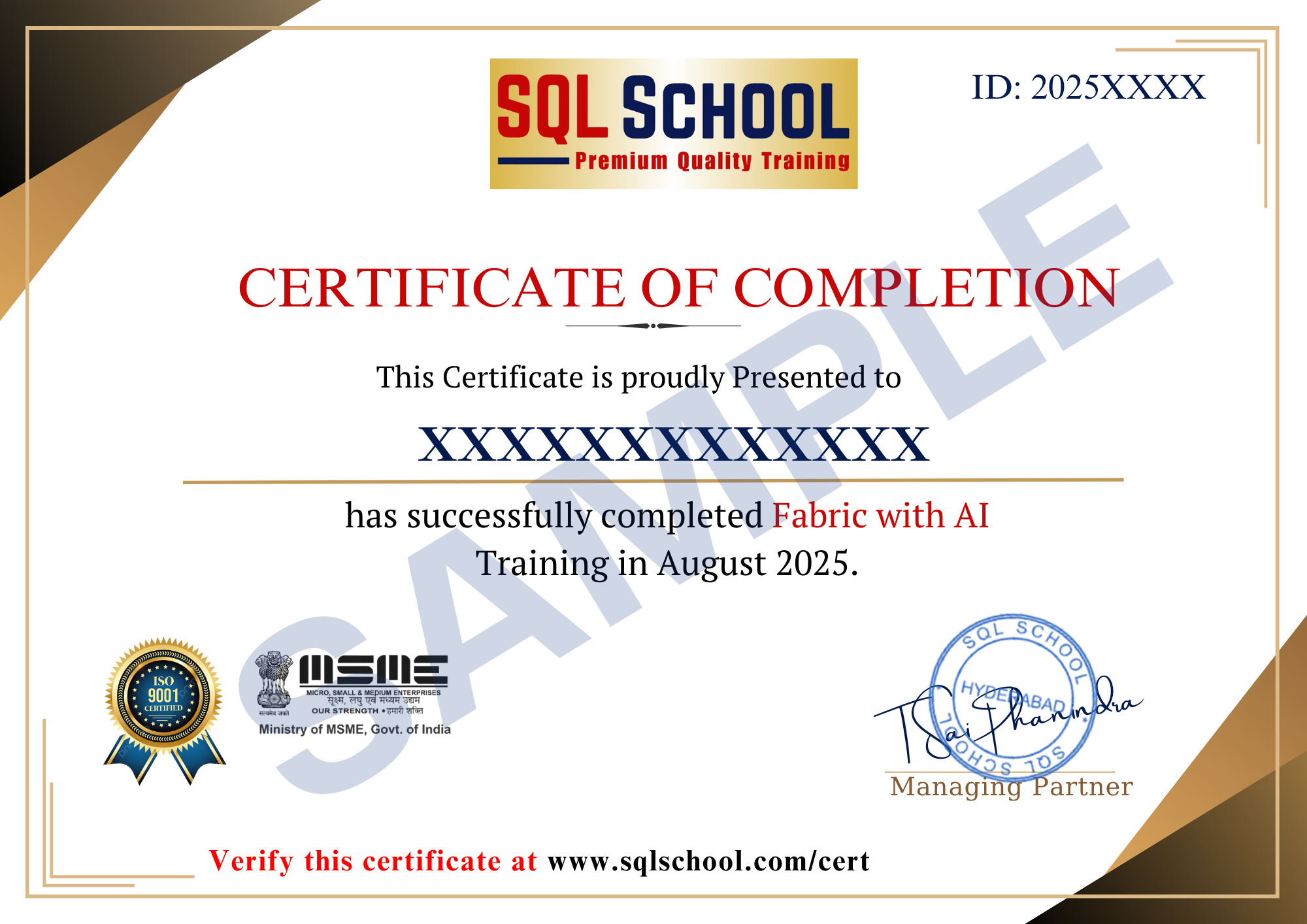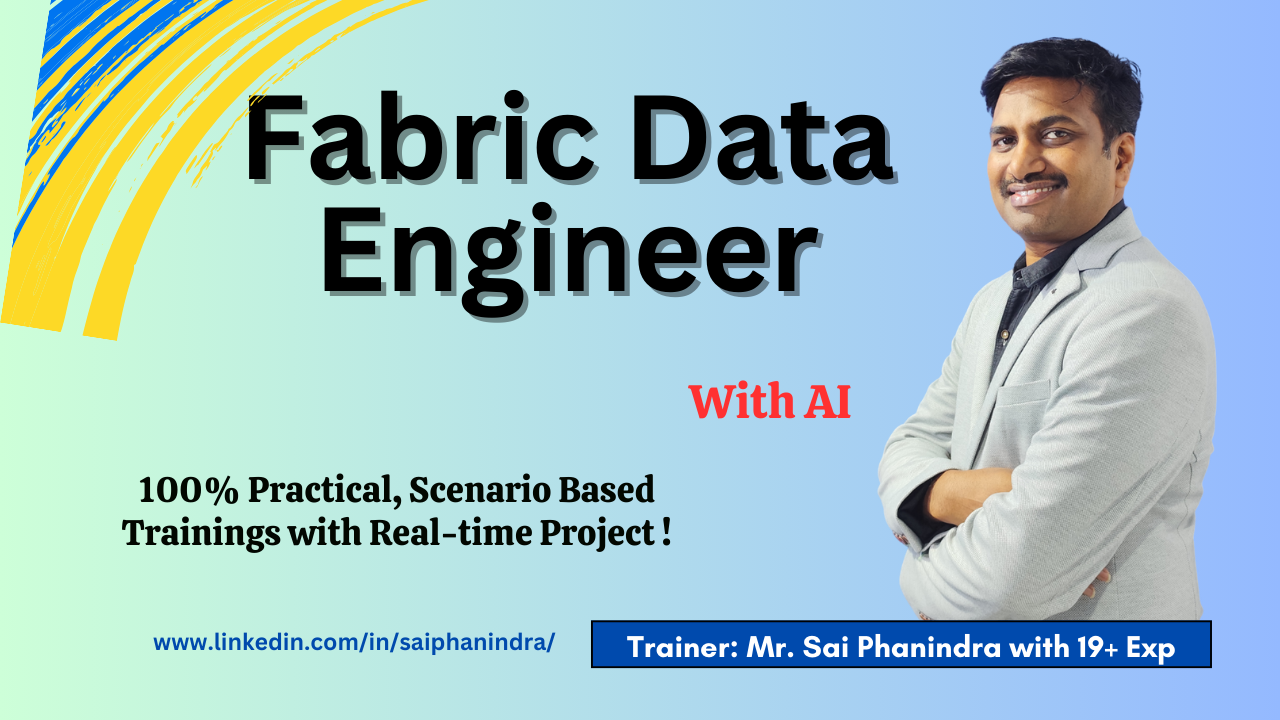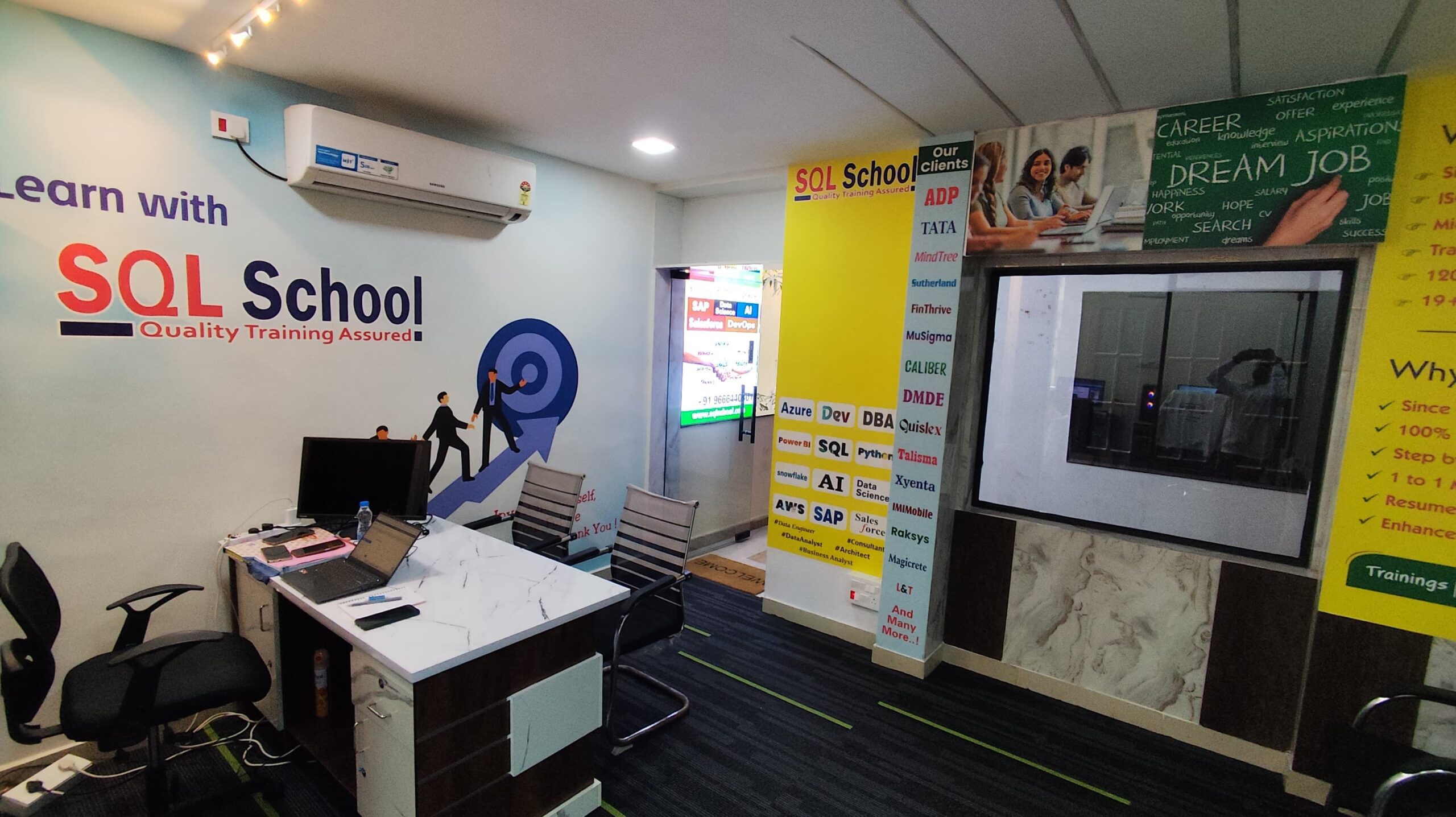
Fabric Data Engineer is the latest trending job role that deals with End to End Data Warehouse design (DWH) using ETL (Extract, Transform, Load) techniques. This prominent job role also involves Big Data Analytics and Business Intelligence implementation using Spark, PySpark, Cloud Computing, TSQL and more..
✅ Fabric Data Factory, Dataflows
✅ Lakehouse with AI Integration
✅ PySpark, Python with Notebooks
✅ Real-Time Eventstream Processing
✅ Semantic Models with AI Insights
✅ Git Integration & CI/CD
✅ Delta Tables & Medallion
✅ End-to-End Fabric AI Project
✅ Real Time Project
✅ 1:1 Mentorship, Resume
Fabric Data Engineer
Training Course Contents:
Module 1 : Microsoft SQL (TSQL)
Ch 1: SQL SERVER INTRODUCTION
- Database Introduction
- Types of Databases
- Need for & ETL, DWH
- BI Implementations
- SQL Server Advantages
- Version, Editions of MSSQL
- Data Analyst Job Roles
Ch 2: SQL SERVER INSTALLATIONS
- SQL Server 2019, 2017
- SSMS Tools Installation
- Database Engine (OLTP)
- SCM, Configuration Tools
- Instance Types, Uses
- Authentication Modes
- Collation, File Stream
Ch 3: SQL BASICS – 1
- Need for Databases, Tables
- Need for SQL Commands
- DDL, DML & DQL Statements
- Database Creation @ GUI
- Data Operations @ GUI
- Session ID, SQL Context
- DB, Tables, Data @ SQL
Ch 4: SQL BASICS – 2
- DDL Variants in MSSQL
- DML Variants in MSSQL
- INSERT & INSERT INTO
- SELECT & SELECT INTO
- Basic Operators in SQL
- Special Operators in MSSQL
- ALTER, ADD, TRUNCATE, DROP
Ch 5: Data Imports, Schemas
- Data Imports with Excel
- ORDER BY & UNION
- UNION ALL For Sorting Data
- Creating, Using Schemas
- Real-world Banking Database
- Table Migrations @ Schemas
- 2 Part, 3 Part & 4 Part Naming
Ch 6 : Constraints, Index Basics
- Need for Constraints, Keys
- NULL, NOT NULL, UNIQUE
- Primary Key & Foreign Key
- RDBMS and ER Models
- Identity Property, Default
- Clustered Index, Primary Key
- Non Clustered Index, Unique
Ch 7: Joins & Views Basics
- JOINS: Purpose. Inner Joins
- Left / Right / Full Outer Joins
- Cross Joins, Query Tuning
- Creating & Using Views
- DML, SELECT with Views
- RLS : WITH CHECK OPTION
- System Views & Metadata
Ch 8: Functions(UDF), Data Types
- Using Functions in MSSQL
- Scalar Value Functions
- Inline & Multiline Functions
- Date & Time Functions
- String, Aggregate Functions
- Data Types : Integer, Char, Bit
- SQL Variant, Timestamp, Date
Ch 9: Stored Procedures,Models
- Stored Procedures & Usage
- Creating, Testing Procedures
- Encryption, Deferred Names
- SPs for Validations, Analysis
- System SPs, Recompilation
- Normal Forms & Types
- Data Models, Self-References
Ch 10: Triggers, Temp Tables
- Need for Triggers
- DDL & DML Triggers
- Using Memory Tables
- Data Replication, Automation
- Local & Global Temp Tables
- Testing & Using Temp Tables
- SELECT .. INTO & Bulk Loads
Ch 11: DB Architecture, Locks
- Planning VLDBs : Files, Sizing
- Filegroups, Extents & Types
- Log Files : VLF, Mini LSN
- Table Location, Performance
- Schemas, Transfer, Synonyms
- Transactions Types, Lock Hint
- Query Blocking Scenarios
Ch 12 : Cursors & CTEs, Links
- Cursors : Realtime Use
- Fetch & Access Cursor Rows
- CTEs for SELECT, DML
- CTEs: Scenarios & Tuning
- Linked Servers, Remote Joins
- Linked Servers: MSDTC, RPC
- Tuning Remote Queries
Ch 13: Merge, Upsert & Rank
- Need for Merge in ETL
- Incremental Loads with SQL
- MERGE and RANK Functions
- Window Functions, Partition
- Identify, Remove Duplicates
Ch 14: Grouping & Cube
- Group By & HAVING
- Cube, Rollup & Grouping
- Joins with Group By
- 3 Table, 4 Table Joins
- Query Execution Order
Ch 15: Self Joins, Excel Analysis
- Self Joins & Self References
- UNION, UNION ALL
- Sub Queries with Joins
- IIF, CASE, EXISTS Statements
- Excel Analytics, Pivot Reports
Module 2: Fabric Data Engineer
Ch 1: Fabric Introduction
- Need for Fabric, Big Data
- Fabric Data Engineering Model
- Fabric Components (Items)
- Microsoft Fabric: Advantages
- Cloud Warehouse Uses
- Benefits of Fabric Over Azure
- Azure Versus Fabric DWH
Ch 2: Fabric Account, Workspace
- Need for Fabric Workspace
- Workspace Creation Process
- Pins and New Items
- Item Categorization
- ETL, Storage, Analytical
- Streaming, Monitoring
- Compute & Separation
Ch 3: Fabric Architecture
- Intelligent Data Foundation
- Polaris Distributed Engine
- Stateless & Stateful
- Cache, Metadata, Xact & Data
- Fabric Tasks, Inputs & DAG
- State Machine & Statistics
- Hot Spot Recovery
Ch 4: Fabric Warehouse
- Fabric Warehouse Creation
- Fabric Warehouse Features
- Fabric Warehouse Properties
- Fabric Warehouse Limitations
- DWH Internal Operations
- Default Schemas & Objects
Ch 5: Fabric Data Types
- Realtime use of Fabric Houses
- Exact, Approximate Numbers
- Date and Time Data Types
- Fixed & Variable Length
- Binary & String Data Types
- Fabric Type Limitations
Ch 6: SSMS Connections
- Warehouse SQL Connection
- Database Engine Server
- Multi Factor Authentication
- Warehouse Artifacts
- Executing .SQL Scripts
- Testing Fabric Artifacts
Ch 7: Fabric Caching
- Fabric Caching Process
- In-memory Cache, Disk Cache
- Cache Types: LRU /MRU
- Cold Cache / Cold Run
- Realtime use of Caching
- Performance Advantages
- Warehouse Optimizations
Ch 8: Fabric Statistics
- Query Engine Options
- Statistics Types
- Leverage Statistics
- Auto, Manual Statistics
- Update Statistics
- Statistics Consistency
- Statistics Lists & Reports
Ch 9: Time Travel
- Continuous Data Protection
- Data Storage, Retention
- FOR TIMESTAMP AS OF
- Time Travel Scenarios
- Time Travel Implementation
- Time Travel on Queries
- Time Travel Limitations
Ch 10: Aggregated Data Store
- Options for Data Aggregations
- Save As table, Save As View
- Single Table Aggregations
- Multi Table Aggregations
- Dynamic Conditions
- Parameterized Aggregations
Ch 11: Zero Copy Cloning
- User Layer, Storage Layer
- Cloning & Parquet Files
- Synapse Data Warehouse
- Data History Retention
- Point In Time , Schema Level
- Zero Copy Cloning Limitations
Ch 12: Fabric Security
- Workspace Security
- Warehouse Security
- Item Security & Roles
- Adding AD Users
- Item Security Limitations
- MFA & Client Security
Ch 13: Fabric Data Factory
- ETL Implementation Options
- Need for Fabric Data Factory
- ETL Operations in FDF
- Data Sources, Transformations
- Data Destinations (Sinks)
- Creating Pipelines
Ch 14: Fabric Pipelines
- Activities and Connections
- Gateways & OnPrem Access
- Data Sets & Activity Sets
- Data Activator & Alerts
- Run ID & Monitoring
- Pipeline Creation, Verification
- Activity Check, Schedule
Ch 15: Fabric Pipelines Design
- Creation Options for Pipelines
- Azure SQL DB Data Loads
- Creating Data Sets
- RRR Transformations
- Copy Command Usage
- Internal Staging (Workspace)
- Data Loads to FDWH
Ch 16: Fabric Aggr Data Loads
- Aggregation Scenarios
- Creating Views in TSQL
- Using Views in FDF Pipelines
- Using Pipeline Editor
- Data Loads to Warehouse
- Pipeline Verifications
Ch 17: ETL Staging
- Staging : Advantages
- Caching & Storing Concept
- Staging Types in Fabric
- Workspace & External
- External Stages in Pipelines
- Compressions & Advantages
- Pipeline Trigger, Monitor
Ch 18: OnPrem Gateways
- Need for On_Premi Gateway
- Installing & Configuring
- Authentication, Usage
- OnPremises Connections
- Pipelines for Data Loads
- Warehouse Data Storage
- Data Refresh with Gateways
Ch 19: Fabric Lakehouse
- Need for Fabric Lakehouse
- Files and Tables Storage
- Data Sources: Parquet Files
- Transformation Options
- Direct Lake Concepts
- Lakehouse Consumption
- Lakehouse Real time Use
Ch 20: Lakehouse File Loads
- Creating Lakehouse
- Copy Data Wizard
- Azure SQL Database Source
- File Data Loads in Lakehouse
- Concurrency & Batch Count
- Pipeline Execution Tests
- Pipeline Monitor Check
Ch 21: Lakehouse Aggr Loads
- Aggregated Data Store
- Plan & Design Aggregations
- Testing Aggregations
- Pipelines for Data Compute
- Data Copy Options
- Pipeline Optimizations
- Data Loads and Verification
- Pipeline Execution Tests
- Pipeline Monitor Check
Ch 22: MultiTable Loads in LH
- Table Loads Connections
- Data Load in Lakehouse
- Using Copy Data Wizard
- Data Store in Lakehouse
- View Run History, Executions
- SQL End Points & Access
- Lakehouse Schemas
Ch 23: Lakehouse Visual Queries
- Visual Query Interface
- Visual Editor & Tables / Views
- Merge, Remove, Sort Tfns
- Data Preview, Save As Table
- Save As View : Advantages
- Using Schemas, Identifiers
- TDS Packets & Transfer Units
Ch 24: File Explorer
- Installing One Lake Explorer
- Autocreation of Folders
- Workspace Directories
- Warehouse Directories, Logs
- Lakehouse Folders, Files
- Lakehouse Uploads
- Explorer Tool Limitations
Ch 25: Power Query Level 1
- Power Query Concept
- Need for Power Query
- Data Flow Gen 1
- Data Flow Gen 2
- Power Query Items
- Differences with Copy Activity
- ETL, ELT Process
Ch 26: Power Query Level 2
- Data Flow Gen2 Operations
- PQ Online Editor
- Working with Binary Content
- Detailed Data Options
- Data Cleansing Options
- Step Names, Aggregations
- Warehouse Data Loads
Ch 27: Power Query Level 3
- Binding Power Query Steps
- Edit / Delete Steps
- Optimizing Power Query
- ETL & ELT with Power Query
- Advanced Editor
- M Language Expressions
- Duplicate / Reference Queries
Ch 28: Fabric Notebooks
- Need for Notebooks
- Fabric Notebook Types
- Get / Prep / Analyze
- Sessions, Markdown Folding
- Standard, High Concurrency
- Magic Command
- Freeze Cells
Ch 29: Spark SQL Notebooks
- Creating Environment
- Creating Spark Clusters
- Spark Cluster Compute
- SQL Analytics in Notebooks
- Visual Query Vs SQL
- Cell Execution Options
- Magic Command Usage
Ch30: PySpark Notebooks
- Creating / Using Environment
- PySpark Notebook Sessions
- Reading Source Data
- Data Prep & Aggregations
- Data Loads, Analytics
- Cell Execution Options
- Markdown Cells
Ch 31: StreamHouse, KQL
- Need for Stream House
- Auto creation of KQL
- Manual KQL Databases
- Verification & Usage
- Differences with Warehouse
- Differences with Lakehouse
Ch 32: KQL Query Sets
- KQL Database ExtractionFile Imports – on Premises
- Metadata Edit Options
- Query Analytics
- Exports, Visualizations
- Query Sets Versus Notebooks
Ch 33: Fabric Data Activator
- Need for Alerts, Notifications
- Fabric Data Activator Options
- Alert Conditions, Thresholds
- Email Notifications
- Events & Notifications
- Edit / Enable / Disable
Ch 34: Model Layouts
- Need for Layouts
- Creating Model Layouts
- Adding Refences, Keys
- Power BI Semantic Models
- Creating Report Items
- Using Power BI Desktop
Ch 35: Azure Synapse Migrations
- Azure Synapse DWH
- Azure Synapse Connections
- Migrating to Fabric
- Compatibility Checks
- Synapse Vs Fabric Warehouse
- Fabric DWH Advantages
Ch 36: DP 700 Exam Guidance
End to End Realtime Project: Ecommerce Domain
Module 3: AI & CoPilot
Ch 1 : Fundamental AI Concepts
- AI: Artificial Intelligence
- Real-time Implementation
- Understand Computer Vision
- Understand Natural Language Processing
- Document Intelligence and Knowledge Mining
- Understand Generative AI
- Challenges and Risks with AI
- Understand Responsible AI
Ch 2: Fundamentals of Machine Learning
- Machine Learning Introduction
- Machine Learning Components
- Types of Machine Learning
- Regression, Binary Classification; Multiclass Classification
- Clustering, Deep Learning
- Azure Machine Learning
Ch 3 : Fundamentals of Azure AI services
- AI Services on Azure platform
- Create Azure AI Service Resources
- Use Azure AI services
- Understand Authentication for Azure AI services
- Exercise – Explore Azure AI Services
Ch 4 : Computer Vision
- Images and image processing
- Machine learning for computer vision
- Azure AI Vision
- Exercise – Analyze images in Vision Studio
Ch 5 : Natural Language Processing
- Understand Text Analytics
- Text Analysis in Azure
- Exercise – Analyze text with Language Studio
Ch 6 : Document Intelligence and Knowledge Mining
- Introduction to Document Intelligence
- Knowledge Mining
- Explore capabilities of document intelligence
- Receipt Analysis on Azure
- Exercise – Extract from data in Document Intelligence Studio
Ch 7 : Generative AI
- What is generative AI?
- What are language models?
- Using language models
- What are copilots?
- Considerations for Copilot prompts
- Extending and developing copilots
- Exercise – Explore Microsoft Copilot
Ch 8 : Generative AI in Azure
- Generative AI – Capabilities within AI in Azure
- Azure Implementation of Gen AI
- Processing Images, Codes and more
Ch 9 : AI 900 Exam Guidance
- Describe Artificial Intelligence workloads and considerations
- Describe fundamental principles of machine learning on Azure
- Describe features of computer vision workloads on Azure
- Describe features of Natural Language Processing (NLP) workloads on Azure
- Describe features of generative AI workloads on Azure
Ch 10 : Azure AI with Azure Data Engineering – 1
- Implementing AI in Cloud
- Co-Pilot Concepts in Big Data
- AI with Azure
- AI with Azure SQL Database
- Automated Query Tuning Concepts (OLTP)
Ch 11 : Azure AI with Azure Data Engineering – 2
- AI with Azure SQL Pool (DWH)
- Automated Query Tuning Concepts (DWH)
- AI Search Service
- Real-world Considerations
Ch 12 : Azure AI with Azure Data Engineering – 3
- AI with Azure Storage Account
- ADLS Concepts and AI Implementations
- AI Search Service with ADLS
- Text Data Handling with AI
Ch 13 : Azure AI with Azure Data Engineering – 4
- AI with Azure Databricks
- Notebook Implementations with AI
- Automated Caching & AI
- AI based Debug Options
- AI based Optimizations with ETL
- AI based Optimizations with DWH
- AI based Troubleshooting with ETL, ELT
Ch 14: Azure AI with Azure Data Engineering – 5
- AI based Optimizations with Medallion Architecture
- End to End Implementations with AI
SQL SCHOOL
24x7 LIVE Online Server (Lab) with Real-time Databases.
Course includes ONE Real-time Project.
#Top Technologies
Who is SQL School? How far you have been in the training services ?
SQL School is a registered training institute, established in February 2008 at Hyderabad, India. We offer Real-time trainings and projects including Job Support exclusively on Microsoft SQL Server, T-SQL, SQL Server DBA and MSBI (SSIS, SSAS, SSRS) Courses. All our training services are completely practical and real-time. CREDITS of SQL School Training Center
- We are Microsoft Partner. ID# 4338151
- ISO Certified Training Center
- Completely dedicated to Microsoft SQL Server
- All trainings delivered by our Certified Trainers only
- One of the few institutes consistently delivering the trainings for more than 20+ Years online as inhouse
- Real-time projects in
- Healthcare
- Banking
- Insurance
- Retail Sales
- Telecom
- ECommerce
I registered for the Demo but did not get any response?
Make sure you provide all the required information. Upon Approval, you should be receiving an email containing the information on how to join for the demo session. Approval process usually takes minutes to few hours. Please do monitor your spam emails also.
Why you need our Contact Number and Full Name for Demo/Training Registration?
This is to make sure we are connected to the authenticated / trusted attendees as we need to share our Bank Details / Other Payment Information once you are happy with our Training Procedure and demo session. Your contact information is maintained completely confidential as per our Privacy Policy. Payment Receipt(s) and Course Completion Certificate(s) would be furnished with the same details.
What is the Training Registration & Confirmation Process?
Upon submitting demo registration form and attending LIVE demo session, we need to receive your email confirmation on joining for the training. Only then, payment details would be sent and slot would be allocated subject to availability of seats. We have the required tools for ensuring interactivity and quality of our services.
Please Note: Slot Confirmation Subject to Availability Of Seats.
Will you provide the Software required for the Training and Practice?
Yes, during the free demo session itself.
How am I assured quality of the services?
We have been providing the Trainings – Online, Video and Classroom for the last 20+ years – effectively and efficiently for more than 100000 (1 lakh) students and professionals across USA, India, UK, Australia and other countries. We are dedicated to offer realtime and practical project oriented trainings exclusively on SQL Server and related technologies. We do provide 24×7 Lab and Assistance with Job Support – even after the course! To make sure you are gaining confidence on our trainings, participans are requested to attend for a free LIVE demo based on the schedules posted @ Register. Alternatively, participants may request for video demo by mailing us to contact@sqlschool.com Registration process to take place once you are happy with the demo session. Further, payments accepted in installments (via Paypal / Online Banking) to ensure trusted services from SQL School™
YES, We use Enterprise Edition Evaluation Editions (Full Version with complete feature support valid for SIX months) for our trainings. Software and Installation Guidance would be provided for T-SQL, SQL DBA and MSBI / DW courses.
Why Choose SQL School
- 100% Real-Time and Practical
- ISO 9001:2008 Certified
- Weekly Mock Interviews
- 24/7 LIVE Server Access
- Realtime Project FAQs
- Course Completion Certificate
- Placement Assistance
- Job Support
















